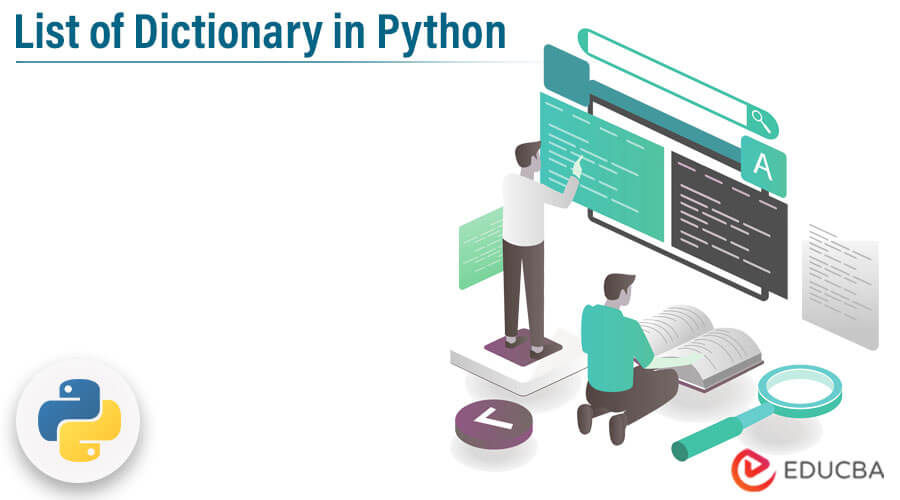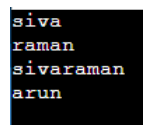Updated February 18, 2023

Introduction to List of Dictionary in Python
The list of dictionary feature in Python is used for creating and retrieving data. It indicates that the data dictionary is included in the element list. It has a separate index and key for creating data in the dictionary list. It will also access all the elements by using the index to get the datas like dict.keys() and other default methods and iterate the datas using loop conditions.
Key Takeaways
- It has default methods to insert and retrieve all the keys and values on the python dictionary.
- It is mostly present in the element list.
- It is one of the efficient ways to search and approach the datas.
- The list contains another list and also it contains another dictionary.
- It covered both ordered and unordered sets of datas.
What is a List of Dictionary in Python mean?
A list of dictionaries helps to indicate that the data dictionary is for a list of elements including the key, and value pairs. It has every set of data segments each one has a separate key and element so the format is ‘key’:element it will go up to n number of entries. It has a list and it contains another list like the same dictionary can contain another dictionary. It can also contain the list and vice versa the python list whose elements are not listed on the python dictionary. Python list is the basic and ensures step for the creation of keys and values in the python dictionary. Append is also possible on the dictionary object of each set element.
How to Create a List of Dictionary in Python?
When we want to create the list of dictionaries first we could set the element on the python list that could be the object of any dataset type. Using some html UI components like iframe and other default options is not for creating a separate dictionary we just keep modifying the same set of dictionary datas and additional references that will be mapped to the dictionary list. We can add a nested list of datas along with the values in the same map collection like key-value pairs should be mapped using the append() method.
Steps to create a list of dictionaries:
1. After installing python, then navigate to python IDLE.
2. Pasting the below code.
Code:
data = [{1: 'siva', 2: 'raman',
3: 'sivaraman', 4: 'arun'}]
print(data[0][1])
print(data[0][2])
print(data[0][3])
print(data[0][4])3. We get the following output results.
How to Access the Key List of Multiple Dictionary in Python?
It has n number of default methods to access the key list datas in the dictionary. Some of the default methods used to access the keys in python dictionary are as follows:
1. Using in operator
It is one of the default methods that can be used to get all the possible keys along with values. The in operator is the most widely used and it’s a highly recommended method for most tasks.
Example:
Code:
x = {"siva" : 1, "raman" : 2, "sivaraman" : 3}
print ("The basic input dictionary is : " + str(x))
print ("DSome of the dictionary inputs are key-value : ")
for i in x :
print(i, x[i])Output:
In the above example, we used an operator for accessing the key from the dictionary list.
2. List comprehension
This method is the second default method which moreover similar to the above one but some logic wises it somewhat bound from one data dictionary list to another. It also processes the data as a key-value pair technique one list is equal and will return the pairs of a dictionary as most tuples key and value in the dictionary list.
Example:
Code:
x = {"Siva" : 1, "rama" : 2, "Sivaraman" : 3}
print ("Welcome To My Domain : " + str(x))
print ("The key results are : ")
print([(k, x[k]) for k in x])Output:
The above example created the variable that stores the input dictionary for keys() function to the same in the input dictionary to get the list of all keys. By using loop condition to iterate the key datas and traversing the same.
3. Unpacking operator conditions
It has a special kind of sequence like * operator for to work and access the datas with iterable object conditions. Because of the data dictionaries, the keys are iterated to generate the list with the iteral format. It has followed a specific set of conditions by using an unpacking operator.
Example:
Code:
inps = {1: 'Siva', 2: 'Raman', 3: 'Sivaraman'}
print([*inps])Output:
In the above example, we used the key-value pair format in passing the inputs. Where as the key is a unique set of identifiers and the value is the string format.
Example of List of Dictionary in Python
Given below is the example mentioned:
Code:
inps = {'1': 'january', '2': 'february',
'3': 'march', '4': 'april'}
keys = ["1", "2", "3"]
resvalue = []
for i in keys:
resvalue.append(inps[i])
print(resvalue)Output:
- In the above example, we used a list of datas in key-value pair format.
- By using a key() and values() method we can split the key and value separately whereas here we cannot use that because it’s a default method to know how many sets of keys and values are in the data dictionary list.
- We can enter the keys in the square brackets with a unique set of identifiers.
- Additionally, we used the append() method to append the keys after getting the iterated value from the for a loop.
- Finally print the results on the screen.
FAQ
Given below are the FAQs mentioned:
Q1. Define a list of dictionaries in python.
Answer:
It makes a suggestion and includes the information in a dictionary to list the components. This proves that the dictionary is one of the lists of elements.
Q2. What is the syntax for the python list of dictionaries?
Answer:
[{‘key1’:element1,’key2’:’element2’,….’keyn’:’elementn’}] is one of the basic syntaxes to list out the dictionary.Q3. How will access the key-value pair in list of dictionaries?
Answer:
By using the index, we can access each dictionary list in python. We know that specific key:value pair of the dictionary by using a key.
Conclusion
In python, the list of dictionaries is the feature to store and retrieve the datas with the list concept. By using key:value pair format the key is generated and it has a unique set of identifiers for accessing from the dictionary with the help of index based generation the key is identified.
Recommended Articles
This is a guide to List of Dictionary in Python. Here we discuss the introduction, how to create list of dictionaries in python? and example. You may also have a look at the following articles to learn more –





